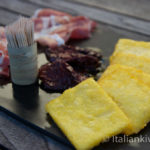
A slight dusting of snow fell on us last week to about the depth of a thin piece of paper, which caused all traffic to ground to a halt. People abandoned their cars on the sides of the roads and to walked through the forest to work, or back home. As you can probably tell, it doesn’t snow often here in the South of France!! My kids were hoping that school would be closed, but unfortunately for them, the people in charge of sending out the text messages to announce the closure of the schools were stuck in un-moving traffic and couldn’t get to the office in time to send out any information. I think they may have to rethink their warning system a little bit. Anyway, all this cold weather and excitement of snow got me to thinking about making polenta: perfect for cold dark evenings to warm you up! Now, it should really be eaten in the mountains after doing some kind of exertion in the snow, like I’m pretending to do in the photo below by holding a ski pole (just for the record: I don’t ski), but you you’ve got to use what you have, in our case a millimeter of snow that melted by 10am was enough………
I love polenta! It’s so versatile! You can eat it in its unadulterated rustic porridgy form (which sounds yucky if you don’t like porridge, but it’s delicious, really!!), you can wait for it to set and then fry it, grill it, or bake it, you can add cheese to it (polenta with gorgonzola’s my favourite!), It can be down home comfort food with any kind of meat stew, or dressed up to be a very elegant side if made into little squares and sautéed (I’ll write the word “sautéed” since it’s meant to be elegant, therefore “fried” sounds a little vulgar, even though they mean pretty much the same thing!) 🙂 My mouth is watering just thinking about it!
Polenta was eaten way back in the days of Caesar. In those days it was made with other types of cereal grains such as farro. Corn arrived from the Americas in the 1600’s, and that was when the polenta as we know it today began to be eaten, particularly in the northern part of Italy. It has been known as a food for the poor for centuries as it is made from easily grown cereals and fills your stomach efficiently so you don’t feel hunger pangs. Now, it has become less class conscious and is eaten by everyone! There are many different kinds of polenta flour: from very fine to coarse. I prefer to make polenta with the finer ground flour as it makes a creamier dish, but if you like a more rustic polenta, use coarser grained flour. Thanks to confusing naming, polenta flour is cornmeal and NOT cornflour (cornstarch). Corn meal is made from grinding the whole corn kernel whereas cornflour is made from the inner part (endosperm) of the kernel. If you try to make polenta with cornflour you will end up with an excellent glue!
The only problem with polenta is that if you make it from scratch, it takes a long time, an eagle eye, and a strong stirring arm to get it cooked. But, never fear my harried, time-constrained friends! I have the solution……yes, you guessed it….I’m going to talk about that pressure cooker again!! Look, just go out and get one, and then I promise that I’ll stop harassing you. I learned how to make polenta in the pressure cooker from my father-in-law. It’s fabulous as there is no, that’s right folks…..NO stirring involved! Well almost none…..just enough to mix the polenta in with the water at the beginning, then a quick whiz with the wooden spoon at the very end. That’s it!

Ingredients
- 250 g 7oz Polenta flour
- 1.5 L 6 cups Water
- 1 tsp Salt
Instructions
- On medium-high on the stove top, bring the water to a simmer, NOT boil. If you have it boiling hard and add the polenta flour, you will get splattered with burning, sticky polenta (trust me on this one.....it hurts!).
- Add salt and stir.
- Turn the heat down to medium. Add the polenta flour in a steady stream while stirring continually. If you don't stir, or you add it all at once, lumps will form.
- Up to now, the method is the same for the regular way of cooking it. If you don't have a pressure cooker, keep stirring the polenta with a wooden spoon for 40 - 50 minutes until it becomes creamy. Add water if the mixture gets too thick.
If you HAVE a pressure cooker:
- The polenta mixture should be very runny, like the consistency of soup. Put the lid on, and immediately lower the heat to medium-low, depending on the strength of your hot-plates. If you are using gas, turn it down to the lowest flame you can.
- Let it cook for 30 minutes. Keep an eye on the pressure. If the safety valve drops down, turn the heat up a little to make it pop up again, then lower the heat again. You don't need to hear the mixture bubbling inside. In fact it's better if you don't. If it is boiling strongly, you will have burnt polenta on the bottom of the pot.
- After 30 minutes, run the pressure cooker under cold water to decrease the pressure.
- Take the lid off and stir the polenta. It's now ready!!
- Note: if the polenta is too thick when it has finished cooking, don't panic. Just add hot water and stir it until it becomes creamy and runnier.
- This recipe is for 2 - 4 people, depending on how you are going to use the polenta.
